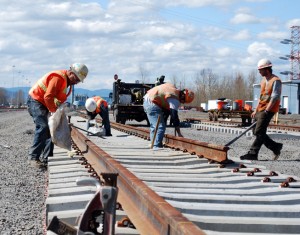Port begins final phase of West Vancouver Freight Access rail projects

Millions in rail congestion relief delivered early and under budget
VANCOUVER, Wash.—The final elements in a decade-long, $275 million effort to improve rail movement at the Port of Vancouver USA are moving toward construction.
The port’s Board of Commissioners in October authorized a $1.6 million construction contract with Railworks Track Systems of Chehalis, Washington. The contract ties together several parts of the port’s West Vancouver Freight Access Project (WVFA) and is the last piece necessary to make the port’s new rail entrance fully operational. It includes:
- Realigning a 500-foot-long section of track between Esther and Grant streets.
- Constructing a double track from Esther Street to the port’s new rail entrance (also known as “the trench”).
- Installing the port’s new main track between companies Albina Fuel and Lafarge at the eastern end of the trench.
“This may be a relatively small contract, but it’s the cap on a very large effort with national importance as far as railways are concerned,” said port commissioner Brian Wolfe. “We’re very close to completion of a project that will reduce rail congestion by 40 percent and help ensure our region’s businesses can compete in the global market.”
Project background
The WVFA began in the early 2000s as a $57 million project to address rail congestion by creating a new rail entrance for the Port of Vancouver. As the port improved its rail system, port tenants began investing in their facilities to take advantage of added capacity. Since its inception, 20 projects have been added to the original WVFA, taking the overall improvements to an estimated $275 million with a completion date of 2017.
Thanks to careful planning and competitive bids during the recent recession, the port now expects to deliver this critical infrastructure as early as 2015 and several million dollars under the estimated cost.
“It took a lot of hard work to deliver this project efficiently, and I’m very proud,” said port CEO Todd Coleman. “A decade ago, pinch points were squeezing our customers and they struggled to keep their cargoes moving, keep their businesses competitive. Now we have more than triple the rail capacity, giving our tenants and customers room to grow.”
The port expects to start work on this phase of construction in December 2014. The entire WVFA is anticipated to be complete well ahead of the 2017 deadline.
WVFA spurs private investment
Port tenants and neighbors, including United Grain Corp., Great Western Malting and Farwest Steel, have already invested more than $200 million in private funds to upgrade facilities and equipment and take advantage of increased capacity.
The port’s expanding rail facilities are also attracting the promise of new private investments. Mega projects and new commodities are betting on the Port of Vancouver’s superb access to river, road and rail, as well as its prime location on the very active trade route between the Midcontinent and the Pacific Rim.
“We expect to see more than $500 million in private investments resulting from the WVFA over the next five years,” said Coleman, “so we aren’t done improving rail infrastructure at the Port of Vancouver. We’ll continue building and improving to support our current tenants’ needs as they grow and find capacity for those who want to bring their business to Vancouver.”
Funding
WVFA was funded as dollars became available from a number of sources, including state and federal grants, tenant investments and funds from BNSF Railway.
The project’s benefits stretch far beyond the Port of Vancouver’s boundaries, which helped the port compete for and earn highly competitive grants, including:
- $15 million federal High Speed Intercity Passenger Rail Program
- $10 million federal Transportation Infrastructure Generating Economic Recovery
- $13 million state Freight Mobility Strategic Investment Board
This influx of federal and state dollars reflects WVFA’s ability to improve efficiency for national freight and passenger rail, and the project’s ability to create jobs and generate revenue for local communities.
By the time it’s complete, the WVFA will create an estimated 4,000 construction jobs and between 1,000 and 2,000 permanent new jobs.
– POV –
The Port of Vancouver USA is one of the major ports on the Pacific Coast, and its competitive strengths include available land, versatile cargo handling capabilities, vast transportation networks, a skilled labor force and an exceptional level of service to its customers and community. For more information, please visit us at www.portvanusa.com.
